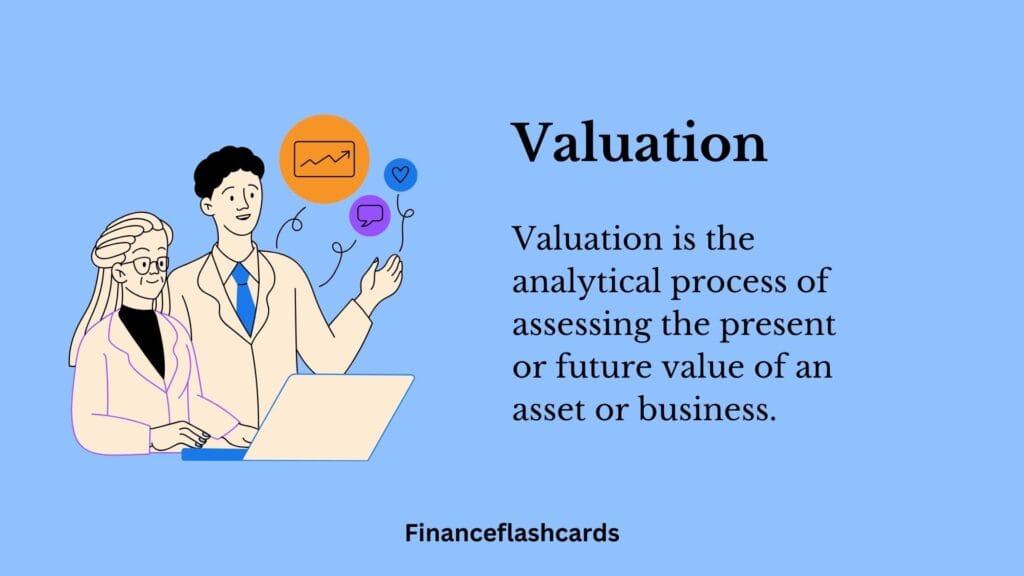Valuation is the analytical process of assessing the present or future value of an asset or business.
Table of Contents
What Is Valuation?
Valuation is the process of estimating the worth of an asset, company, or investment.
Knowing what an asset is worth and what determines that value is a prerequisite for intelligent decision-making — in choosing investments for a portfolio, in deciding on the appropriate price to pay or receive in a takeover and in making investment, financing and dividend choices when running a business.
Valuation is quantitative in nature, but it often includes some degree of subjectivity in input or assumptions.

Understanding Valuation
The premise of valuation is that we can make reasonable estimates of value for most assets, and that the same fundamental principles determine the values of all types of assets, real as well as financial.
Valuation is the process of determining the worth of an asset, business, or investment in financial terms. It provides a clear understanding of how much something is currently worth or could be worth in the future.
This concept is widely used in finance for purposes such as making investment decisions, setting the price for a sale or purchase, or evaluating the performance of a business.
Approaches to Valuation
Analysts use a wide spectrum of models, ranging from the simple to the sophisticated. These models often make very different assumptions about the fundamentals that determine value, but they do share some common characteristics and can be classified in broader terms.
- The first, discounted cash flow valuation, relates the value of an asset to the present value of expected future cash flows on that asset.
- The second, relative valuation, estimates the value of an asset by looking at the pricing of ‘comparable’ assets relative to a common variable like earnings, cash flows, book value or sales.
- The third, contingent claim valuation, uses option pricing models to measure the value of assets that share option characteristics.
Discounted Cash Flow Valuation
In discounted cash flow valuation, the value of an asset is the present value of the expected cash flows on the asset, discounted back at a rate that reflects the riskiness of these cash flows.
In discounted cash flow valuation, we begin with a simple proposition. The value of an asset is not what someone perceives it to be worth, but it is a function of the expected cash flows on that asset.
Put simply, assets with high and predictable cash flows should have higher values than assets with low and volatile cash flows. In discounted cash flow valuation, we estimate the value of an asset as the present value of the expected cash flows on it.
Relative Valuation
In relative valuation, we value an asset by looking at how the market prices similar assets. Thus, when determining what to pay for a house, we look at what similar houses in the neighbourhood sold for rather than doing an intrinsic valuation.
Extending this analogy to stocks, investors often decide whether a stock is cheap or expensive by comparing its pricing to that of similar stocks (usually in its peer group).
Contingent Claim Valuation
In recent years, though, analysts have increasingly used option-pricing models, developed to value listed options, to value assets, businesses and equity stakes in businesses.
These applications are often categorised loosely as real options, but they have to be used with caution.
A contingent claim or option is an asset which pays off only under certain contingencies – if the value of the underlying asset exceeds a pre-specified value for a call option, or is less than a pre-specified value for a put option.
Valuation in Corporate Finance
Valuation plays a crucial role throughout a firm’s life cycle. For small businesses seeking funding, it helps determine the equity venture capitalists demand in exchange for capital.
As companies grow and go public, valuation sets the pricing for public offerings. Established firms rely on valuation to guide investment decisions, borrowing, and returns to owners, aligning with the corporate goal of maximising firm value.
Value enhancement has become a key focus for CEOs and consultants, who use tools like EVA and CFROI to drive shareholder satisfaction and improve firm performance by understanding and leveraging the factors that influence value.
Limitations of Valuations
Valuation has limitations as it relies heavily on assumptions like growth rates, discount rates, and market conditions, which can be uncertain or biased. External factors like economic changes or industry trends can also impact accuracy.
Some methods, such as DCF, may not suit businesses with unpredictable cash flows, and subjective judgments in choosing inputs can lead to variations. Thus, valuation should be seen as an estimate, cross-verified with other methods for greater reliability.
Closing Thoughts
Valuation is a critical tool for understanding and determining the worth of assets, companies, and investments. It influences key decisions like funding, pricing, and strategic investments. While it involves uncertainty and assumptions, proper use of valuation models can provide valuable insights, guiding businesses to maximize their value and achieve long-term success.

